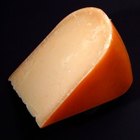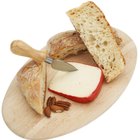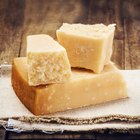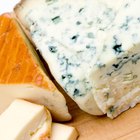
Due to USDA regulations regarding safe cheese production, some varieties of unpasteurized cheese are processed abroad and cannot be imported to the United States. In other areas such as England, France and the Alps, unpasteurized cheese is readily available. This category of cheese is usually more flavorful because it is prepared using lower cooking temperatures. The following cheeses are unpasteurized.
Gloucester
There are two types of Gloucester cheese, single and double. Made in England, production of this cheese started as early as 1498 using sheep's milk. Today the cheese is made in much the same manner as it was back then. It is made in large dairies and on small farms alike. The farm-made cheese is usually less expensive and not as creamy as the dairy-made cheese.
There was a time when Double Gloucester cheese was preferred over the single variety. Therefore, Single Gloucester was typically imported, while Double Gloucester was predominantly sold in England.
Gloucester cheese is sold in wheels and larger blocks. It is light orange in color, has an oniony taste and is typically allowed to mature for two to four months. This cheese gets harder as it ages. The flavor loses some of its mellowness and takes on a nuttier taste. It is good in salads and as part of a cheese tray.
Gruyere
Gruyere cheese is a Swiss cheese. There is more than one variety of Gruyere. It is similar to Emmenthaler, another unpasteurized cheese. Gruyere is typically aged three to six months and has a somewhat sharp flavor.
This cheese is classified a hard cheese. It stores well for one month or more. Gruyere that begins to mold or starts to lose butterfat should be discarded.
Because this cheese melts well, it is a good choice for soups, fondues and au gratin dishes. Combine it with other cheeses such as Parmesan, for added taste. It is often served with fresh fruit, for dessert.
Grana Padano
Grana Padano is an Italian cheese. It was originally produced by Cistercian monks prior to the 1400s. In 1954, a consortium was formed to guarantee its quality. It is a cow's milk cheese that has both a savory and sweet flavor and is typically aged between 12 and 22 months. Grana Padano is made into wheels of cheese.
It is usually grated and used as a recipe ingredient or sliced and consumed with other foods like crackers and fruit.
Related Articles

What Good Bacteria Is in Cheese?

What Is Animal Rennet?

Cheeses Similar to Feta

How to Store Parmigiano Reggiano

A List of Dutch Cheeses

Substitute for Shredded Parmesan Cheese

Can You Melt Ricotta?

MSG and Parmesan Cheese

Facts About Gouda Cheese

Can You Substitute Mascarpone With ...

Does a Sliced American Cheese Product ...

Do You Thaw Frozen Cheese Before ...

How to Freeze Cheeses

What Type of Microorganism Is Used to ...
Can I Eat My Cheddar Cheese Past the ...

What Are Rennet Tablets?

The Difference Between Fresh Cheese & ...

Aged Cheeses That Do Not Melt

Difference Between White Cheddar & ...

How to Crumble Gorgonzola Cheese